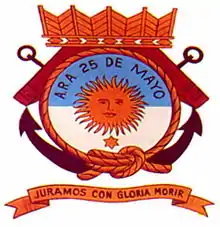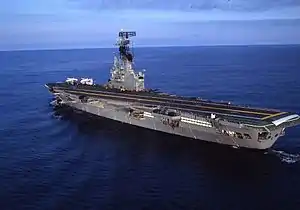ARA Veinticinco de Mayo (V-2)
ARA Veinticinco de Mayo (V-2) was an aircraft carrier in the Argentine Navy from 1969 to 1997. The English translation of the name is Twenty-fifth of May, which is the date of Argentina's May Revolution in 1810.
 Veinticinco de Mayo | |
| History | |
|---|---|
| Name: | HMS Venerable (R63) |
| Ordered: | 7 August 1942 |
| Builder: | Cammell Laird |
| Yard number: | 1126 |
| Laid down: | 3 December 1942 |
| Launched: | 30 December 1943 |
| Commissioned: | 27 November 1944 |
| Decommissioned: | April 1947 |
| Fate: | Sold to the Netherlands 1 April 1948 |
| Name: | HNLMS Karel Doorman (R81) |
| Namesake: | Karel Doorman |
| Acquired: | 1 April 1948 |
| Commissioned: | 28 May 1948 |
| Decommissioned: | 29 April 1968 |
| Refit: |
|
| Fate: | Sold to Argentina 15 October 1968 |
| Name: | Veinticinco de Mayo |
| Namesake: | Date of the May Revolution |
| Acquired: | 15 October 1968 |
| Commissioned: | 12 March 1969 |
| Decommissioned: | 1997 |
| Out of service: | Inoperable by 1990 |
| Refit: | 1969 |
| Homeport: | Puerto Belgrano Naval Base |
| Fate: | Provided spare parts for NAeL Minas Gerais and remainder was scrapped in 2000 |
| General characteristics | |
| Class and type: | Colossus-class aircraft carrier |
| Displacement: | 19,900 tons |
| Length: | 192 m (630 ft) |
| Beam: | 24.4 m (80 ft) |
| Draught: | 7.5 m (25 ft) |
| Propulsion: |
|
| Speed: | 24 knots (44 km/h) |
| Complement: | 1,300 |
| Armament: | 12 × 40 mm AA guns |
| Aircraft carried: | 21 |
The ship previously served in the Royal Navy as HMS Venerable and the Royal Netherlands Navy as HNLMS Karel Doorman. She was deployed south during the Beagle Crisis in 1978 and in the first weeks of the Falklands War (Spanish: Guerra de las Malvinas), where her aircraft were deployed against the Royal Navy task force, but spent the bulk of the war in port.[1]
History

The ship was built for the Royal Navy by Cammell Laird in Birkenhead, England during the Second World War.[2] As a Colossus-class aircraft carrier, she was named HMS Venerable and saw service in the British Pacific Fleet. Venerable only served three years in the Royal Navy before being sold to the Netherlands as HNLMS Karel Doorman.
After a boiler room fire, the carrier was rebuilt, and sold to Argentina.[2] The Argentines already operated a carrier, ARA Independencia, also a former Royal Navy Colossus-class. After Independencia was decommissioned in 1970, Veinticinco de Mayo was the sole remaining carrier in the Argentine fleet. She could carry up to 24 aircraft.
The air group started with F9F Panthers and F9F Cougar jets and later these were replaced with A-4Q Skyhawks supported by S-2 Tracker anti-submarine warfare aircraft and Sikorsky Sea King helicopters.
In September 1969, during the voyage of the recently bought Veinticinco de Mayo from the Netherlands, Hawker Siddeley demonstrated their Harrier GR.1 on board the carrier for a possible sale to the Argentine Navy.
.jpg.webp)
During the 1970s the ship was refitted and updated several times, though in each case the duration of each repair period was never more than 3–5 months, allowing her to be available to deploy. Her last pre-Falklands refit occurred during 1981, when she received an update to her radar, arresting gear, steam catapult and (most noticeably) the forward edge of the port side angled deck was filled out via an enlarged sponson. These improvements would theoretically enable her to operate the Super Etendard strike aircraft purchased from France, but it was discovered during testing that the catapult had difficulties launching the aircraft type. As a result, her strike airwing was limited to the A-4Q Skyhawks.
Beagle Conflict

During the Operation Soberania Veinticinco de Mayo was planned to support the invasion of the Picton, Nueva and Lennox islands.
Falklands War
During the Falklands War, Veinticinco de Mayo was used in support of the initial Argentine landings on the Falklands.[3] On the day of the invasion, she waited with 1500 army soldiers outside Stanley harbour as first submarine and boat-landed commandos secured landing areas, and then Argentine marines made the main amphibious landing. Her aircraft were not used during the invasion.[4] Later, in defence of the occupation, she was deployed in a task force north of the Falkland Islands, with ARA General Belgrano to the south. The British had assigned HMS Splendid (S106),[5] a nuclear-powered submarine, to track down Veinticinco de Mayo and sink her if necessary. Rear Admiral Sandy Woodward, commanding the British task force from HMS Hermes stated in his book One Hundred Days that, had Splendid located the carrier, he would have "Recommended in the strongest possible terms to the Commander-in-Chief Admiral Sir John Fieldhouse that we take them both out this night".[6]
Following the outbreak of hostilities on 1 May 1982, the Argentine carrier planned an attack on the Royal Navy Task Force. Veinticinco de Mayo's S-2 Trackers detected the British fleet late that day, and a strike by all eight A-4Q Skyhawk jets was prepared, scheduled to take-off at dawn. The attack, did not take place, because subsequent Tracker sorties had failed to relocate the British fleet.[7] After the British nuclear-powered submarine HMS Conqueror sank General Belgrano, Veinticinco de Mayo returned to port.[8] The naval A-4Q Skyhawks flew the rest of the war from the airbase in Río Grande, Tierra del Fuego, and had some success against the Royal Navy, sinking HMS Ardent. Three Skyhawks were shot down by Sea Harriers.
Disposal
In 1983, Veinticinco de Mayo was modified to carry the Super Étendard,[9]Video and her British-built CAAIS combat data system was replaced by a Dutch SEWACO system, which was compatible with the Argentine Navy's new Almirante Brown-class destroyers. From 1986, problems in her engines largely confined her to port; rendering her unserviceable.[10]
Work began in 1988 to refit the carrier, with it being planned to replace her steam turbines with gas turbines, while providing an auxiliary steam plant to power the ship's steam catapults. By 1994, the ship's machinery had been removed, but a shortage of funds led to work stopping.[10][11] In December 1996, the Argentine Navy announced that Veinticinco de Mayo would be discarded.[12] By this time, she had already been stripped of various major pieces of equipment, which were used as spares for the Brazilian carrier NAeL Minas Gerais, another Colossus-class ship which had been heavily modified in the Netherlands.[13] Finally, in 2000, she was towed to Alang, India for scrapping.[11]
Although Minas Gerais was offered to the Argentine Navy in 2000 as a replacement, she was rejected, due to her poor condition and high restoration and maintenance costs. Argentine cooperation with Brazil has meant that the naval air wing continued to operate from the deck of carrier NAe São Paulo during ARAEX exercises while she was in service, and/or touch-and-go landings on US Navy carriers when they are in transit within Argentine coastal waters during Gringo-Gaucho manoeuvres.
See also
References
Notes
- "The Falkland Islands – A history of the 1982 conflict". RAF. Archived from the original on 21 September 2008.
- Ireland, p. 147
- http://www.globalsecurity.org/military/world/argentina/25-de-mayo.htm
- "The Falkland Islands Conflict, 1982: Air Defense Of The Fleet". www.globalsecurity.org.
- Lawrence Freedman (2005). The Official History of the Falklands Campaign: War and diplomacy. Psychology Press. p. 267. ISBN 978-0-7146-5207-8.
- Admiral Sandy Woodward One Hundred Days, pages 207 and 208. ISBN 978-0-00-713467-0
- Burden et al 1986, pp. 39–40, 49–50
- Burden et al 1986, p. 50
- Moore 1985, p. 11
- Gardiner and Chumbley 1995, p. 6
- Hobbs 2013, p. 195
- Baker 1998, p. 7.
- "Archived copy". Archived from the original on 29 February 2012. Retrieved 24 August 2008.CS1 maint: archived copy as title (link)
Bibliography
- Baker, A. D., III, ed. (1998). The Naval Institute Guide to Combat Fleets of the World 1998–1999. Annapolis, Maryland, USA: Naval Institute Press. ISBN 1-55750-111-4.
- Burden, Rodney A.; Draper, Michael I.; Rough, Douglas A.; Smith, Colin R.; Wilton, David (1986). Falklands: The Air War. British Aviation Research Group. ISBN 0-906339-05-7.
- Gardiner, Robert; Chumbley, Stephen, eds. (1995). Conway's All The World's Fighting Ships 1947–1995. Annapolis, Maryland, USA: Naval Institute Press. ISBN 1-55750-132-7.
- Hobbs, David (2013). British Aircraft Carriers: Design, Development and Service Histories. Barnsley, UK: Seaforth Publishing. ISBN 978-1-84832-138-0.
- Ireland, Bernard (2007). The Illustrated Guide to Aircraft Carriers of the World. London: Anness Publishing Limited, Hermes House. p. 147. ISBN 978-1-84477-747-1.
- Moore, John, ed. (1985). Jane's Fighting Ships 1985–86. London: Jane's Yearbooks. ISBN 0-7106-0814-4.
Further reading
- Bishop, Chris; Chris Chant (2004). Aircraft Carriers. London: Summertime Publishing Ltd. p. 83. ISBN 0-7603-2005-5.
- Donald, David; Daniel J. March (2001). Carrier Aviation Air Power Directory. Norwalk, CT: AIRtime Publishing. p. 91. ISBN 1-880588-43-9.
- Secondi, Martín; Jorge A. Leguizamón (1999). 25 de Mayo Portaaviones (in Spanish). Buenos Aires, Argentina: Ayer y Hoy Ediciones. p. 72. ISBN 987-9249-06-2.
- Sciaroni, Mariano (2019). A Carrier at Risk: Argentinean Aircraft Carrier and Anti-Submarine Operations Against Royal Navy's Attack Submarines During the Falklands/Malvinas War, 1982. Latin America@War. Helion. ISBN 978-1-911628-70-5.
External links
| Wikimedia Commons has media related to ARA Veinticinco de Mayo (V-2). |
- Historical Pictorial
- Google Video of Super Etendards practicing touch & go on ARA 25 de Mayo
- Google Video of A-4 Skyhawks on ARA 25 de Mayo
- Naval-History.net HMS Venerable